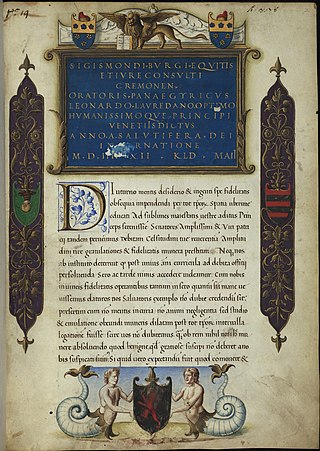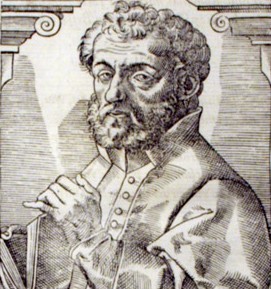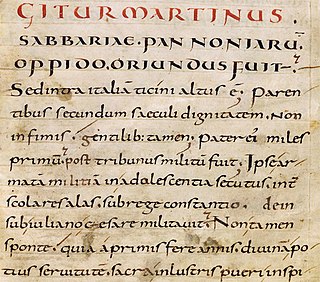
The Renaissance is a period in history and a cultural movement marking the transition from the Middle Ages to modernity, covering the 15th and 16th centuries and characterized by an effort to revive and surpass ideas and achievements of classical antiquity; it occurred after the crisis of the Late Middle Ages and was associated with great social change in most fields and disciplines, including art, architecture, politics, literature, exploration and science. In addition to the standard periodization, proponents of a "long Renaissance" may put its beginning in the 14th century and its end in the 17th century.

A panegyric is a formal public speech or written verse, delivered in high praise of a person or thing. The original panegyrics were speeches delivered at public events in ancient Athens.

George of Trebizond was a Byzantine Greek philosopher, scholar, and humanist.

A hagiography is a biography of a saint or an ecclesiastical leader, as well as, by extension, an adulatory and idealized biography of a preacher, priest, founder, saint, monk, nun or icon in any of the world's religions. Early Christian hagiographies might consist of a biography or vita, a description of the saint's deeds or miracles, an account of the saint's martyrdom, or be a combination of these.

Renaissance humanism was a worldview centered on the nature and importance of humanity, that emerged from the study of Classical antiquity. This first began in Italy and then spread across Western Europe in the 14th, 15th, and 16th centuries. During the period, the term humanist referred to teachers and students of the humanities, known as the studia humanitatis, which included the study of Latin and Ancient Greek literatures, grammar, rhetoric, history, poetry, and moral philosophy. It was not until the 19th century that this began to be called humanism instead of the original humanities, and later by the retronym Renaissance humanism to distinguish it from later humanist developments. During the Renaissance period most humanists were Christians, so their concern was to "purify and renew Christianity", not to do away with it. Their vision was to return ad fontes to the simplicity of the Gospels and rediscovery of the New Testament, bypassing the complexities of medieval Christian theology.

The Italian Renaissance was a period in Italian history covering the 15th and 16th centuries. The period is known for the initial development of the broader Renaissance culture that spread across Western Europe and marked the transition from the Middle Ages to modernity. Proponents of a "long Renaissance" argue that it started around the year 1300 and lasted until about 1600. In some fields, a Proto-Renaissance, beginning around 1250, is typically accepted. The French word renaissance means "rebirth", and defines the period as one of cultural revival and renewed interest in Classical antiquity after the centuries during what Renaissance humanists labelled as the "Dark Ages". The Italian Renaissance historian Giorgio Vasari used the term rinascita ("rebirth") in his Lives of the Most Excellent Painters, Sculptors, and Architects in 1550, but the concept became widespread only in the 19th century, after the work of scholars such as Jules Michelet and Jacob Burckhardt.

Lorenzo Valla was an Italian Renaissance humanist, rhetorician, educator and scholar. He is best known for his historical-critical textual analysis that proved that the Donation of Constantine was a forgery, therefore attacking and undermining the presumption of temporal power claimed by the papacy. Lorenzo is sometimes seen as a precursor of the Reformation.

Late Latin is the scholarly name for the form of Literary Latin of late antiquity. English dictionary definitions of Late Latin date this period from the 3rd to the 6th centuries CE, and continuing into the 7th century in the Iberian Peninsula. This somewhat ambiguously defined version of Latin was used between the eras of Classical Latin and Medieval Latin. Scholars do not agree exactly when Classical Latin should end or Medieval Latin should begin.
Gustave Reese was an American musicologist and teacher. Reese is known mainly for his work on medieval and Renaissance music, particularly with his two publications Music in the Middle Ages (1940) and Music in the Renaissance (1954); these two books remain the standard reference works for these two eras, with complete and precise bibliographical material, allowing for almost every piece of music mentioned to be traced back to a primary source.

The Baths of Diocletian were public baths in ancient Rome. Named after emperor Diocletian and built from AD 298 to 306, they were the largest of the imperial baths. The project was originally commissioned by Maximian upon his return to Rome in the autumn of 298 and was continued after his and Diocletian's abdication under Constantius, father of Constantine.
A senex amans is a stock character of classical Greek and Roman comedy, medieval literature and drama. It is an old jealous man married to a young woman and thus often an object of mockery. He is variously ugly, impotent, puritanical, and foolish to be cuckolded by a young and handsome man. Often the term senex amans is applied to the very motif involving the three.

Mirabilia Urbis Romae is a much-copied medieval Latin text that served generations of pilgrims and tourists as a guide to the city of Rome. The original, which was written by a canon of St Peter's, dates from the 1140s. The text survives in numerous manuscripts.

The praefectus urbanus, also called praefectus urbi or urban prefect in English, was prefect of the city of Rome, and later also of Constantinople. The office originated under the Roman kings, continued during the Republic and Empire, and held high importance in late Antiquity. The office survived the collapse of the Western Roman Empire, and the last urban prefect of Rome, named Iohannes, is attested in 599. In the East, in Constantinople, the office survived until the 13th century.
Laudatio florentinae urbis is a panegyric delivered by Leonardo Bruni. The panegyric is modeled after Aelius Aristides' Panathenaic Oration, particularly with references to Florence's values and external threats. It was first delivered immediately after Florence's victory over Milan.
Laudes Mediolanensis civitatis, also known as the Versum de Mediolano civitate or Versus in laudem mediolanensis civitatis, is an early medieval Latin poem, which describes and praises the Italian city of Milan. It dates from the mid-8th century, during the era of the Lombard Kingdom. The poet is unknown. The poem is an encomium, an example of the urban eulogy genre. It celebrates not only the Christian heritage of Milan, but also its pagan Roman history. It is considered to be the earliest surviving medieval description of a city. The poem served as a model for the Carolingian Versus de Verona, a similar encomium to its rival Verona, written around 50 years later.
De mirabilibus urbis Romae, preserved in a single manuscript in Cambridge, England, is a medieval guide in Latin to the splendours of Rome, which was written in the mid-twelfth century by a certain Magister Gregorius of Oxford. The outlook here is even more secular than the Mirabilia Urbis Romae, Roberto Weiss noted. Gregorius spent much of his time describing and even measuring the Roman ruins, and, according to Erwin Panofsky "had yielded so thoroughly to the 'magic spell' of a beautiful Venus statue that he felt compelled to visit it time and again in spite of its considerable distance from his lodgings". Magister Gregorius is the first to take notice of the Roman bronze called the "Spinario", then among ancient bronzes at the Lateran. Panofsky included Magister Gregorius's little book among examples of the reawakening of interest in classical antiquities evinced by a handful of connoisseurs in twelfth-century Rome. Still, like most of his contemporaries raised in familiarity with the Gothic hand, the unfamiliar Roman letters in inscriptions sometimes eluded his translation.

The topography of ancient Rome is the description of the built environment of the city of ancient Rome. It is a multidisciplinary field of study that draws on archaeology, epigraphy, cartography and philology. The word 'topography' here has its older sense of a description of a place, now often considered to be local history, rather than its usual modern meaning, the study of landforms.

De laude Cestrie, also known as Liber Luciani de laude Cestrie, is a medieval English manuscript in Latin by Lucian of Chester, probably a monk at the Benedictine Abbey of St Werburgh in Chester. Believed to date from the end of the 12th century, it has been described as "the oldest extant piece of Cheshire writing," and, with its first-hand description of the medieval town of Chester, is one of the earliest examples of prose writing about an English urban centre. It is also notable for the earliest extended description of Chester's county palatine status, which Lucian writes "gives heed ... more to the sword of its prince than to the crown of the king." The original manuscript is held by the Bodleian Library, Oxford. Excerpts have been published in 1600, 1912 and 2008.
Durham, also known as De situ Dunelmi, Carmen de situ Dunelmi or De situ Dunelmi et de sanctorum reliquiis quae ibidem continentur carmen compositum, is an anonymous late Old English short poem about the English city of Durham and its relics, which might commemorate the translation of Cuthbert's relics to Durham Cathedral in 1104. Known from the late 12th-century manuscript, Cambridge, University Library, Ff. 1. 27, Durham has been described both as "the last extant poem written in traditional alliterative Old English metrical verse" and as being placed "so conveniently on the customary divide between Old and Middle English that the line can be drawn right down the middle of the poem." Scholars have dated the poem either to the twelfth century or to some point in the second half of the eleventh century.
Der Rosendorn is a thirteenth-century German poem. It tells of a virgin who is separated from her vagina, and her dialogue with it forms the structure of the piece. They argue about what it is that men want in a woman: the woman claims that men want for herself and her beauty, whereas the cunt dismisses this, claiming that she is all men really want. The two go different directions to discover the truth; neither is successful, and both are treated badly by the men they meet. To conclude the story, the maid is physically reunited with her cunt with the assistance of a passing young man.













